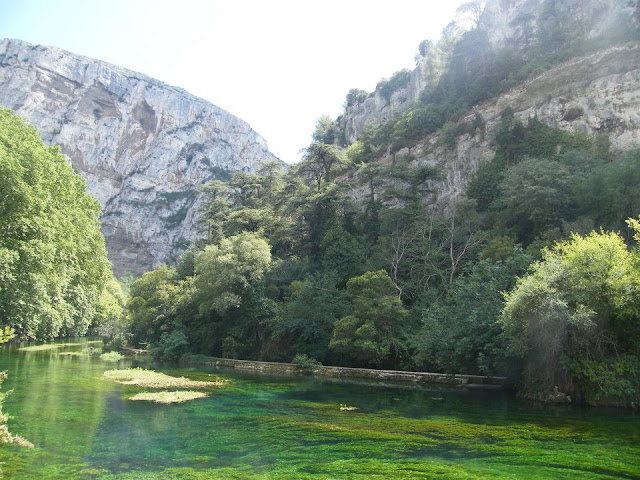Several rivers criss-cross the region of Provence. Some of them start their lives as sources in the hills, or from glacial waters in the Alps, tumbling their way down towards the warm waters of the med.
There is, of course, the Rhone, over which stretches the famous Pont d'Avignon, and whose delta forms the salt marshes and creeks of the Camargue. There is also its famous tributary, the Durance, a rocky, chilly alpine river running through Sisteron and Cavaillon before converging with the Rhone near Avignon.
 |
| View from the Palais de Pâpes onto the Pont d'Avignon |
Water from the Durance was brought to Marseille in the 19th century, via the Canal de Marseille, an artificial concrete channel running some 80-odd kilometers to supply the city with running water, after outbreaks of disease such as cholera. So great was the need for water, that its arrival was celebrated by the construction of the fabulous Palais Longchamp in the centre of town, with its spectacular fountains and lush green gardens. The gardens behind the palace originally housed a zoological park, and the old enclosures still exist, including a quaint giraffe house. The palace now plays host to a fine art museum, and a small natural history museum.
On my first day in Marseille, flat-hunting, I remember stumbling across the Palais Longchamp on the tram - noone really sings its praises or tells you to go there. And yet it is, for me at least, one of the most spectacular sights in the city. Go there. Climb the palace steps and look out over the city, then climb a little higher, find a spot under a tree and read a book, or sip a café crème and watch the pony-and-trap take children for rides around the park. A little haven of calm in the middle of France's busiest city.
Water from the Verdon river was also later brought to Marseille - and to some of the other large towns nearby - in the 1970s via the Canal de Provence, which runs almost totally underground (and uncelebrated!). The Marseillais are unusually proud of their water, and cannot understand why tourists might prefer bottled varieties to the stuff that comes out of taps. Apparently, a real pastis is made with water from Marseille; if not, it doesn't taste the same... Mind you, it was a marseillais that told me that, so take it with a pince of salt.
But water is not only celebrated in Marseille; the small village of Eyguières, north of the military town of Salon de Provence, claims to have the largest number of fountains in any village in France. Istres, a small town on the Etang de Berre, has the highest single water jet (Geneva-style) in France. The beautiful town of Isle-sur-la-Sorgue is, perhaps predictably given the name, built on an island in the middle of the Sorgue river, connected to the shore by a series of bridges. A walking tour of the waterwheels that surround the town - as well as its antiques markets and bookshops - is well worth doing.
You cannot, however, visit Ile-sur-la-Sorgue without going to the the church in the centre. On a scorching hot day strolling around this town with a friend, we decided to nip inside just to cool off a little. Decorated from floor to ceiling with wonderfully detailed, flaking paintings, it is simply breathtaking.
Nearby is the wonderfully green village of Fontaine de Vaucluse, which is built around France's largest natural spring, in the shadows of a set of magnificent cliffs. Famous french diver Jacques Cousteau attempted to dive the spring, but didn't make it down to the bottom. Pictures of this place speak for themselves.















I was just thinking about Isle-sur-Sorgue yesterday as I cooked tarte a l'indienne which I first had in a restaurant on the banks of the Sorgue- au Chineur- well worth another visit!
ReplyDeleteThat was a great little restaurant, and such reasonable prices. I wonder if they have a website?
Delete